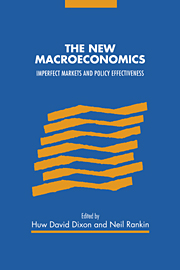Book contents
- Frontmatter
- Contents
- List of contributors
- Preface
- Acknowledgements
- Introduction
- Part I Overviews and perspectives
- Part II Goods market imperfections
- Part III Labour market imperfections
- 7 Demand uncertainty and unemployment in a monopoly union model
- 8 Efficiency wages as a persistence mechanism
- 9 Efficiency, enforceability and acyclical wages
- 10 Business fluctuations, worker moral hazard and optimal environmental policy
- Part IV Financial market imperfections
- Part V Nominal rigidities and bounded rationality
- Bibliography
- Index of authors
- Index of subjects
7 - Demand uncertainty and unemployment in a monopoly union model
Published online by Cambridge University Press: 13 October 2009
- Frontmatter
- Contents
- List of contributors
- Preface
- Acknowledgements
- Introduction
- Part I Overviews and perspectives
- Part II Goods market imperfections
- Part III Labour market imperfections
- 7 Demand uncertainty and unemployment in a monopoly union model
- 8 Efficiency wages as a persistence mechanism
- 9 Efficiency, enforceability and acyclical wages
- 10 Business fluctuations, worker moral hazard and optimal environmental policy
- Part IV Financial market imperfections
- Part V Nominal rigidities and bounded rationality
- Bibliography
- Index of authors
- Index of subjects
Summary
Introduction
In unionized economies, nominal wages are normally set for a relatively long period of time, say one year, while employment fluctuates during the year depending on firms' particular situations. The standard ‘right to manage’ model, as in McDonald and Solow (1981), even if it assumes that wages are set before the firm decides employment, does not reflect completely this important sequence in the decision process, assuming that both decisions are taken under the same information concerning the environment. In this chapter, new information is revealed in between both decisions, allowing the firm to decide employment with richer information than the union has when deciding wages. This sequence in the wage bargaining process leans on the assumption of nominal wage rigidities.
Many different types of uncertainty are relevant to the analysis of wage bargaining. Information concerning the aggregate price index, as in Lucas (1972) must generate some type of Lucas supply curve. Technological uncertainty or aggregate demand uncertainty could also be important to explain the behaviour of employment and wages over the business cycle, as is reported by Hansen and Wright (1992). However, we concentrate our attention on the effects of demand uncertainty coming from misinformation about individual preferences. As is frequently reported in the literature on marketing, firms are mainly concerned with forecasting their market shares. However, macroeconomists seem to be more interested in the effects of technological shocks and aggregate demand shocks than in the effects that idiosyncratic demand shocks have on the aggregate equilibrium.
- Type
- Chapter
- Information
- The New MacroeconomicsImperfect Markets and Policy Effectiveness, pp. 173 - 185Publisher: Cambridge University PressPrint publication year: 1995



